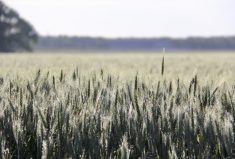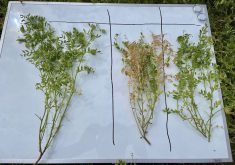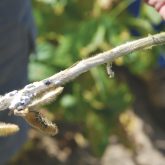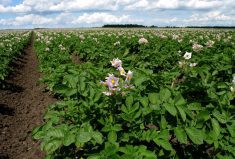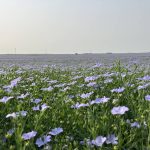In the early ’90s, farmers in the eastern Prairies started to ask questions about odd white “tombstone” wheat kernels. When they received the answer, some wondered whether the name would refer to the tombstone on the grave of the wheat business, especially when there was a huge outbreak in Manitoba in 1993. Near-panic ensued, as next door in North Dakota, much of the crop was written off by crop insurance and burned because of concerns that the crop was literally toxic.
The cause was the now-familiar fusarium head blight (FHB), which has now spread across the Prairies. The early panic has subsided, and the industry has learned that the problem can be managed by rotation, fungicides and cleaning. But is there a simpler solution, namely planting varieties that don’t get the disease in the first place?
Read Also

Sensing the soil: Root cell research finds ‘stress hormone’
Research into how root cells react to soil stressors could help plants better adapt to changes in their climate.
Simple for the farmers, but not so simple for plant breeders. Yet they say progress has been made, and is continuing.
Last February, the Western Grains Research Foundation (WGRF) announced $21.4 million in checkoff funding for Agriculture and Agri-Food Canada wheat and barley breeding projects to be delivered over the next five years.
WGRF executive director Garth Patterson says fusarium resistance breeding and research is a key priority for the programs and projects funded by the organization.
Across the country, several researchers are studying fusarium from every angle, from pathology to agronomy. This November, many will gather in Ottawa to discuss their findings at the eighth Canadian Workshop on Fusarium Head Blight. On the agenda are resistance breeding, cereal genomics, pathogen genomics and disease management.
Not a single disease
Fusarium is a tough nut to crack, partly because there are multiple species in Canada.
“In the eastern Prairies, Manitoba and Saskatchwan, Fusarium graminearum is the main pathogen,” explains Anita Brûlé-Babel, a wheat breeder at the University of Manitoba. “As you move west you see more fusarium pathogens, more prevalent in some years than others. For instance, Fusarium culmorum tends to be more adapted to cooler conditions.” Southwestern Saskatchewan sometimes hosts yet another pathogen, Fusarium avenaceum.
But Brûlé-Babel says that the genes selected for resistance tend to respond across species, which is good news for breeders.
Every wheat breeding project in Canada screens for new sources of fusarium resistance. Brûlé-Babel is leading the University of Manitoba’s WGRF-funded work in fusarium resistance in winter wheat.
She is currently working with graduate students to map new resistance genes in winter wheat and using marker-assisted selection to screen breeding materials. She oversees Western Canada’s largest FHB nursery, to which wheat breeders can send genetic materials to be evaluated for fusarium response.
“In that nursery we provide data for variety registration trials for spring wheat and winter wheat,” she says.
This year, Brûlé-Babel is also overseeing studies on whether varieties respond differently to different isolates of the pathogen and how effective fungicides are with different levels of resistant genotypes.
We’ve also started another project looking at fall rye, because there’s no data on fusarium in fall rye in Western Canada, she says.
Cross-prairie collaboration
Brûlé-Babel’s is not the only lab in Western Canada focused on fusarium, and collaboration happens at all levels when it comes to resistance breeding.
This means new fusarium-resistant varieties are reaching the market sooner. Brûlé-Babel says there’s been a big improvement in the availability of resistant varieties over the last five years. Red spring has more resistant types because it has the most breeders working on the problem.
“Proportion wise we’ve made quite a shift — the majority of lines proposed are in the intermediate to moderately resistant categories. Right now we’re looking at 56 per cent of the newer varieties being intermediate to moderately resistant,” Brulé-Babel says.
Durum resistance is the least developed, because good natural sources of resistance don’t exist in the gene pool. But University of Saskatchewan Crop Development Centre (CDC) wheat breeder Curtis Pozniak, who was recently involved with assembling the durum wheat genome, is engaged in a SaskWheat/SeCan project at CDC developing new varieties with improved disease resistance.
“We’re still making progress, and we’ve seen a shift to improved resistance, but we’re not at a level where farmers can say ‘My crop is safe from fusarium,’” says Brûlé-Babel.
Challenges
Brûlé-Babel says breeding for resistance is complex because resistance itself is complex: five types of fusarium resistance have been identified. Type 1, for example, resists infection to start with, Type 2 is resistant to disease spread in the spike, and Type 3 is resistant to toxin accumulation.
“With all of these types of resistance, evaluating where it comes from and how the mechanisms operate is complicated,” Brûlé-Babel says.
“The final thing people have to understand with this pathogen is that even the resistance we have is not complete. Leaf and stem rust resistance can be quite complete, but with fusarium that’s not the case,” she explains. “We’re trying to reduce the level of disease to the point where we can increase the grade and market the crop.”
Gina Feist, research program manager for WGRF, says Canada’s research and breeding efforts are on par with those of the U.S. (whose efforts are concerted by the U.S. Wheat and Barley Scab Initiative). Though cross-border collaboration is limited, as Canadian and U.S. wheat and barley varieties are different, it does happen.
“It’s a worldwide, multi-crop issue, and Canadian scientists are linked in with international efforts. That’s probably the best way to beat this long term,” Patterson says.
“My hope is that we can sustain the progress, and through these technologies and genomics be able to make greater gains,” says Feist.
So it looks as if genetic solutions are on the way. But meanwhile, producers are advised to stay on their guard against fusarium — to choose resistant varieties, practice crop rotation, monitor environmental conditions, stay abreast of FHB forecasts, and use fungicides, paying careful attention to timing of application.




